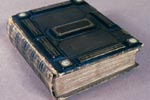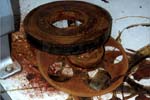Topics in Preservation Science
 |
 |
 |
 |
CAMEO: A Free Internet Reference on Materials Used in the Production and Conservation of Historic and Artistic Works
September 19, 2008, 10:30 - 11:30 a.m.
Dining Room A, 6th floor James Madison Building
ABOUT THE LECTURE:
What is Coade Stone? When was Bakelite invented? What is the chemical structure of indigo? Is it safe to use mineral spirits? The answers to all of these questions and much more can be found on CAMEO at cameo.mfa.org. CAMEO (Conservation and Art Materials Encyclopedia Online) is an electronic database of terms, materials and techniques used in all aspects of conservation and production of artistic, architectural, archaeological, and anthropological materials. CAMEO consolidates text and images for the use, understanding, and identification of materials and delivers the merged information to diverse audiences via the Internet. CAMEO increases access to formerly obscure information, creates a historical context for the use of materials in art conservation, and provides a chronological record of materials as they are developed or changed. Produced by the Museum of Fine Arts, Boston, CAMEO is a free service for the benefit of professional conservators, the museum, libraries, and archives community, and the general public.
ABOUT THE SPEAKER:
 Michele
Derrick has been a contract conservation scientist at the Museum of Fine
Arts, Boston since 1995 where she was instrumental in the development
of CAMEO. She has served as the compiler, editor, and principal investor
for the database. Prior to 1995, she worked at the Getty Conservation
Institute in Los Angeles for 12 years. A chemist by training, Michele’s
expertise is in the area of infrared microspectroscopy; she is the author
of Infrared Spectroscopy in Conservation Science (Los Angeles: Getty
Conservation Institute, 1999). She is also currently the editor–in–chief
of the Journal of the American Institute for Conservation.
Michele
Derrick has been a contract conservation scientist at the Museum of Fine
Arts, Boston since 1995 where she was instrumental in the development
of CAMEO. She has served as the compiler, editor, and principal investor
for the database. Prior to 1995, she worked at the Getty Conservation
Institute in Los Angeles for 12 years. A chemist by training, Michele’s
expertise is in the area of infrared microspectroscopy; she is the author
of Infrared Spectroscopy in Conservation Science (Los Angeles: Getty
Conservation Institute, 1999). She is also currently the editor–in–chief
of the Journal of the American Institute for Conservation.
